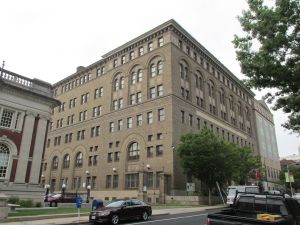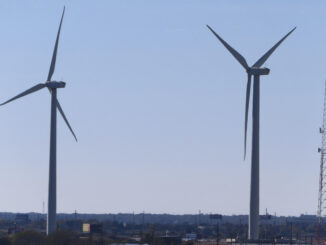
Dana Van Steenburgh wasn’t instantly opposed when the Verogy solar company proposed a 4.9-megawatt project on open farmland directly across from his brand new home in East Windsor, Connecticut.
He participated in an informational online session hosted by the developer and asked a lot of questions. In the end, “I felt like they were going to be good neighbors,” Van Steenburgh, 68, said.
But when the 29-acre project on East Road went into operation in late 2021, Van Steenburgh immediately heard a constant ringing in the air from electrical equipment at the site. What he describes as an “annoying high-pitched tone,” audible whenever it was sunny, followed him into his front and back yards.
His next-door neighbor Josh Bergendahl, 33, was bothered as well by what he describes as a “high-pitched fan noise.”
“As soon as the sun comes up until it goes down,” Bergendahl said. “When I had friends come over to my house, they would say, ‘How can they think that’s acceptable?’”
Get connected
Every morning, thousands of energy professionals turn to our newsletters for the day’s most important news. Sign up for free to get the latest delivered straight to your inbox.
Eighteen months later, the noise persists, despite numerous complaints from neighbors and the efforts of local elected officials to get the matter resolved. Adding to neighbors’ annoyance, the dozens of arborvitae planted by the developer to help shield the solar panels from public view — a requirement for the project’s approval — have mostly turned brown and died.
The project, East Windsor Solar One, reveals the limits of what state and local officials can do if problems arise with solar farms once they are in place. The Connecticut Siting Council sets the conditions for their approval, and those conditions are enforceable. But this case fell into what appears to be a gray area.
“Technically, the noise at the site is not over the allowed decibel level, but it’s still a true nuisance,” said Rep. Jaime Foster (D-Ellington, East Windsor), who hears the “buzzing” when she passes the site while out running.
While the dispute doesn’t appear to represent a broader problem — experts say noise issues can be easily mitigated through project design — it does threaten to become an albatross for the industry in an area where elected officials say they are being asked to bear more than their fair share of solar development.
First Selectman Jason Bowsza, the top elected official in this town of roughly 11,000 people, first relayed neighbors’ complaints about noise from the East Road array in an email to the siting council in January of 2022.
“I would ask that you kindly provide remedies available to the homeowners who are left to bear the effect of the solar development on their homes,” he wrote.
By this time, Verogy, which is based in West Hartford, had sold the project to NextEra Energy Resources, the renewable energy development arm of Florida-based NextEra. The siting council immediately sent a letter to Lee Hoffman, a lawyer for Verogy, and the designated NextEra representative requesting that they conduct a noise study at the property lines of the neighbors across the street.
Solar panels themselves are silent, but the equipment that connects them to the grid can produce noise, similar to any electrical transformer such as the cylinder-shaped enclosures that sit atop utility poles. Sound can also come from inverters, which convert the DC power generated by solar panels to AC power that can be used on the grid.
The lawyer for Verogy responded to Bowsza’s letter a few days later, saying that two company representatives had visited the site and, using a sound meter, determined that the noise was within the decibel levels allowed under the conditions of approval. However, he said, “both Verogy representatives acknowledge that sounds from the inverters were heard at the property line of the project,” and they are reviewing options to “potentially” install a sound barrier.
“They saw reputationally they were still at risk, even though legally, they’re out,” Bowsza said in an interview.
Bowsza sent another email to the council in March relaying noise concerns from another neighbor. The council requested an update from Hoffman, who replied that Verogy planned to hire an acoustical engineering consulting firm to perform an acoustic study and design a noise mitigation solution.
In the meantime, he said, they were seeking permission to construct a “temporary sound baffle” inside the fencing at the north end of the project. The council granted that approval.
In March 2023, a full year later, Bowsza again wrote to the council, noting that the developer was aware of the noise issue and had indicated that they would take steps to mitigate it.
“To date, to my knowledge, and based on communications received recently from residents, no mitigation has occurred,” he said.
While town zoning regulations don’t apply to the project, Bowsza said, he was directing the town building official to determine if conditions at the project are in compliance with state building and fire codes.
“The project manager for East Windsor Solar One is not acting in good faith, and has not acted in good faith, and the residents are owed timely relief,” he said.
The same day, Hoffman submitted a brief letter to the council saying that “no definitive plans have been made” for sound mitigation. However, this time he noted that because the project is in compliance with the required decibel limits, “additional sound control designs are not mandatory.”
The simplest, least-cost way to ensure that noise is not audible to neighbors of a solar development is to site the equipment on a non-noise-sensitive property line, such as away from houses, said Michael Bahtiarian, a principal at Acentech, an acoustical consulting firm based in Cambridge, Massachusetts, who has worked on a number of solar projects.
“In that case, the noise control just comes from added distance,” he said.
If that isn’t possible, developers can install a noise barrier, which is “a one, two, three or potentially four-sided wall around the equipment,” he said. “Usually a three-sided wall is what you would put up — it blocks sound in one direction but allows for air flow.”
With proper acoustical engineering ahead of time, solar arrays can easily be quiet neighbors, Bahtiarian said.
While NextEra had been previously unresponsive to the matter, a company representative recently communicated to Bowsza and Rep. Foster that the company is working on a mitigation plan.
“I’m hoping we get somewhere soon,” Foster said. “It’s giving a bad name to an industry. It makes it hard for me, as the vice chair of the Energy and Technology Committee, to do the work that I’m doing. You want to be able to say that these are good for the environment. But in small towns, everyone knows everyone. And everyone is upset on behalf of those neighbors.”
A spokesperson for Verogy said the company could not comment on the project because it is no longer the owner.
NextEra’s media office did not offer a company representative to respond to questions.
While other projects have not generated similar complaints, the problems on East Road are stoking opposition to new proposals. Just over the border in Ellington, for example, residents are opposing a solar facility proposed on farmland by another developer, citing in part the noise and dead trees at the East Windsor project.
Foster sponsored a legislative amendment this year that would have given municipalities the authority to block projects located within five miles of an existing solar project larger than 100 MW. East Windsor is host to a 120 MW solar project — the largest in the Northeast — being built on 485 acres of fields, woods and sand and gravel quarries.
It passed in the House but did not receive a vote in the Senate before the legislative session concluded this month.
Van Steenburgh thinks the siting regulations ought to be revised to ensure that a situation like the one he’s in doesn’t happen again.
“The siting council needs to be more diligent in looking at sites before approval,” he said.



